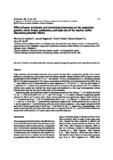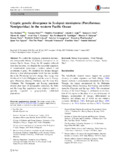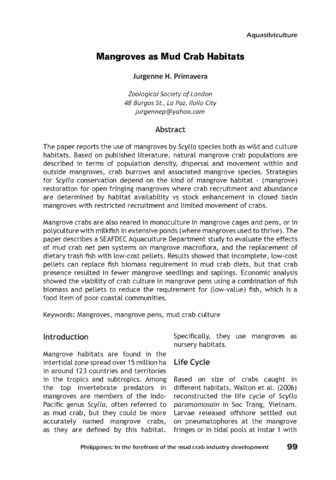Effect of some vertebrate and invertebrate hormones on the population growth, mictic female production, and body size of the marine rotifer Brachionus plicatilis Müller
Share
Abstract
Eight vertebrate and invertebrate hormones were screened for their effect on population growth, mictic female production, and body size of the marine rotifer Brachionus plicatilis. Growth hormone (GH) or human chorionic gonadotropin (HCG) at 0.0025-25 I.U. ml-1 and estradio1-17β (E2), triiodothyronine (T3), 20-hydroxyecdysone (20-HE), 5-hydroxytryptamine(5-HT), gamma-aminobutyric acid (GABA) or juvenile hormone (JH) at 0.05-50 mg l-1 were added to 5-ml of Nannochloropsis oculata suspension (7 x 106 cells ml-1). From an initial density of 1 individual ml-1, rotifers were cultured with hormones for 48 hours in 22 ppt seawater at 25 °C, in darkness. Rotifers were counted and classified into female types and transferred to a new algal food suspension without hormone every other day until day 8 when body size was measured. Population growth was significantly higher in treatments exposed to GABA (50 mg l-1), GH (0.0025 and 0.025 I.U. ml-1), HCG (0.25 and 2.5 I.U. ml-1), and 5-HT (5 mg l-1). E2 caused a decrease in population growth, whereas JH, 20HE, and T3 had no effect. Mictic female production was significantly higher at 0.05 and 0.5 mg l-1 JH and 0.05 and 5 mg l- 5HT. GH (0.0025 and 0.025 I.U. ml-1), E2 (50 mg l-1 ), GABA (0.5, 5 and 50 mg l-1), and 20-HE (0.05 mg l-1) treatments had significantly higher mictic female production only on day 8, 6, 4, and 6, respectively. T3 and hCG had no effect on mictic female production. Lorica length increased by 9.6% and 4.4% in rotifers treated with JH (0.05 mg l-1) and GABA (5 mg l-1), respectively. Correspondingly, lorica width increased by 8.9% and 2.6% in these treatments. In comparison, 20-HE-, T3-, and HCG-treated rotifers were smaller (3.9-8.2%) and GH, 5-HT and E2 had no effect on rotifer body size.
Suggested Citation
Gallardo, W. G., Hagiwara, A., Tomita, Y., Soyano, K., & Snell, T. W. (1997). Effect of some vertebrate and invertebrate hormones on the population growth, mictic female production, and body size of the marine rotifer Brachionus plicatilis Müller. Hydrobiologia , 358(1-3), 113-120. https://doi.org/10.1023/A:1003124205002
Subject
Collections
- AQD Journal Articles [1248]
Related items
Showing items related by title, author, creator and subject.
-
Approaches in Rebuilding Sea Urchin and Sea Cucumber Populations in the Philippines
Meñez, Marie Antonette J. (Training Department, Southeast Asian Fisheries Development Center, 2016)Sea urchins and sea cucumbers are among the most valuable and overexploited fishery resources. Culture and release of juvenile Tripneustes gratilla and Holothuria scabra have been undertaken to rebuild depleted populations ... -
Cryptic genetic divergence in Scolopsis taenioptera (Perciformes: Nemipteridae) in the Western Pacific Ocean
Kakioka, Ryo; Muto, Nozomu; Takeshima, Hirohiko; Gaje, Arnold C.; Cruz, Ramon S.; Alama, Ulysses B.; Guzman, Armi May T.; Traifalgar, Rex Ferdinand M.; Babaran, Ricardo P.; Muda, Osman; Arshaad, Wahidah Mohd; Arnupapboon, Sukchai; Phuttharaksa, Kamolrat; Nguyen, Quan Van; Pham, Thu The; Motomura, Hiroyuki; Muto, Fumihito; Ishikawa, Satoshi (Springer Verlag, 2018)We studied the phylogeny, population structure, and demographic history of Scolopsis taenioptera in the western Pacific Ocean. Using the 80 samples collected from four locations, we obtained the nucleotide sequences of ... -
Mangroves as mud crab habitats
Primavera, Jurgenne (Aquaculture Department, Southeast Asian Fisheries Development Center, 2017)The paper reports the use of mangroves by Scylla species both as wild and culture habitats. Based on published literature, natural mangrove crab populations are described in terms of population density, dispersal and ...





